When the weather gets into the triple digits, whether you’re in a dry or humid climate, no matter how you look at it… it’s just HOT! And if it’s hot for us, can you imagine what it must feel like to our pets, especially our St. Bernards… you know that breed of ours that thrives in cold weather, preferring snow to deserts. I’m not saying that they cannot tolerate hot weather, with care, they can, but like us, they won’t be excited about it.
So how hot is too hot for St. Bernards? Temperatures above 80°F (26°C) can cause discomfort and anything above 90°F (32°C) becomes hazardous for them.
St. Bernards are mountain rescue dogs that were bred to withstand crazy harsh alpine conditions. What is it about them that makes them so adaptable to such extreme weather?? There are several factors:
- High tolerance to Altitude: this means that they can handle lower oxygen levels that are found in higher elevations. Higher elevations/altitudes and thinner air means colder temperatures.
- Large body mass: St. Bernards are impressive size-wise. They have a larger body mass that enables them to retain heat in cold weather (which can also moderate their body temperature in warmer weather)
- Thick double coat: this consists of a soft and dense undercoat and a rougher, longer outer coat. This coat protects against both hot and cold and acts as natural insulation.
- Built for snow: they can navigate snowy terrain with ease due to their powerful limbs and webbed feet… again, making them suitable for colder environments
So now we know some reasons why they don’t have a high heat tolerance, what can we do to make sure our furry little buddies stay comfortable?
If, for some reason, you cannot keep or have your St. Bernard inside with the air conditioner during the summer, there are some things to consider.
Outdoors
When the temps rise, a Saint’s energy is zapped, and you can find them stretched out under a nearby shady tree. They can tolerate temperatures that are 90-plus but not without protection from the sun. A doghouse isn’t the best protection from the sun because it doesn’t get adequate ventilation. So, we will want to ensure that our Saints have access to shaded areas, especially during peak sunlight hours.
Don’t forget to avoid hot surfaces! Walking on hot pavement can burn their paws.
A St. Bernard expends energy in quick bursts, they love to romp and run, but they’re also BIG on napping! Limit physical activity during the hottest part of the day to avoid overexertion. Schedule playtime and walks for early mornings before it gets too hot.
Use cooling mats or damp towels for your dog to lay on to help lower body temperature.
Hydration
Fresh water is essential for keeping a St. Bernard cool and hydrated during hot weather. Left in the sun, a water bowl quickly heats up and by mid-afternoon, the water temperature can reach over 100 degrees. Put the water bowl in the shade and change the water at least twice daily. Consider installing an on-demand water spigot on your hose hydrant that emits fresh water every time your dog drinks. Always keep an additional bowl of water handy, however, in case the on-demand spigot malfunctions.
Traveling when it’s warm
In the car, get some of those sun blinds to go in the windows to keep the sun from shining through the windows onto their fur. Be sure to take fresh water (and a bowl) on any trips lasting longer than an hour.
If you’re flying, not all commercial airlines have temperature-controlled holds. This means that it is possible that your Saint could become dangerously overheated on flights without access to water. So, make sure to chat with the airline before buying your pooch a ticket.
Hot Cars
Now, this should not have to be said, but I will say it anyhow. Under NO circumstances should St. Bernards (ANY dog, cat, child, etc.) be left unattended in hot cars. Temperatures inside a car can escalate rapidly, leading to life-threatening conditions, even with the windows down. Ok so even if you have done everything possible to keep your furry family member safe and cool during the soaring high temperatures, we still need to pay attention to make sure we know what to watch for and when to see immediate veterinary attention.
Signs of Heatstroke
- Excessive panting or difficulty breathing: If your Saint is panting constantly or faster than normal (hyperventilation), they could be overheated.
- Gums and Tongue: Bright red, gray, purple, or bluish gums and bright red tongue. If your dog’s gums are a different color than normal
- Dehydration: Signs include dry nose, visible tiredness, excessive panting, and sunken eyes.
- Lethargy or weakness: If your St. Bernard appears weak, fatigued, or having trouble standing up and walking.
- Dizziness: If Saint seems to have trouble walking in a straight line or keeps bumping into furniture.
- Vomiting or diarrhea: An abnormally soft stool, or a stool with blood in it, could be a big warning sign for heat exhaustion.
- Muscle tremors: If your dog is shivering or shaking regardless of outside temperature, it may be caused by heat exhaustion.
How To Treat Heat Exhaustion
- Take your Saint to a cooler area (preferably indoors) immediately.
- Lower their body temperature by wetting them thoroughly with cool water. Do not use cold water! It seems counterintuitive, but cooling too quickly can be just as dangerous as heat exhaustion. For very small dogs or puppies, use lukewarm water instead of cool.
- Apply more cool water around their ears and paws. This helps reduce fever.
- Put them in front of a fan to dry off. If you have a pet thermometer handy, check their temperature every few minutes (note: don’t use a glass thermometer that your dog might bite and break). Once their temperature drops to 103 degrees (F), remove the fan and stop applying water.
- As they continue to cool down, provide them with small amounts of lukewarm or cool water to drink. Again, not cold water, and no ice!
- Call your veterinarian as soon as possible. Even if your Saint seems to be recovering, they may need to be monitored for shock, dehydration, kidney failure, and other possible complications of heat exhaustion. Your vet will be able to advise you about the next steps.
If your dog loses consciousness or seems severely ill (vomiting, seizing, etc.) get to a veterinary hospital immediately.
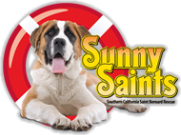


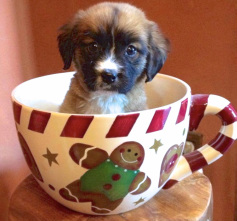
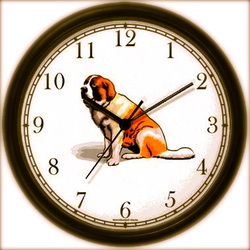
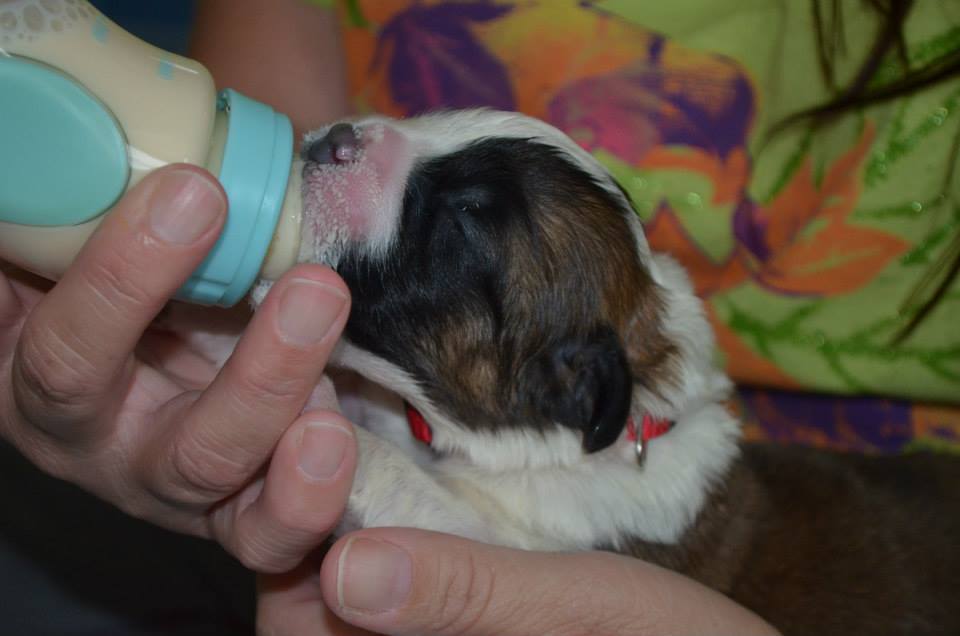
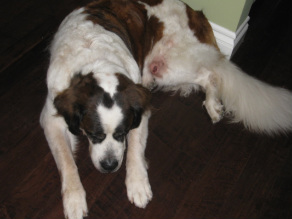
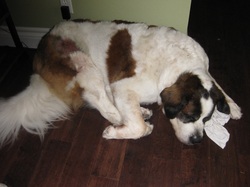
 RSS Feed
RSS Feed